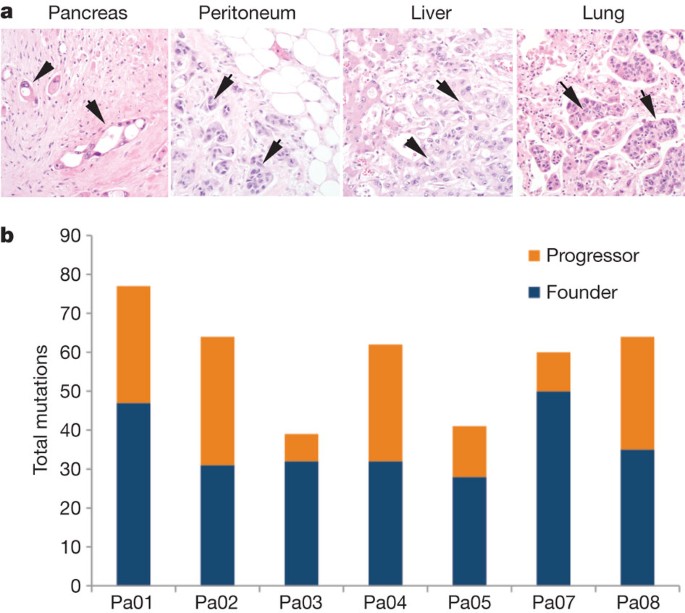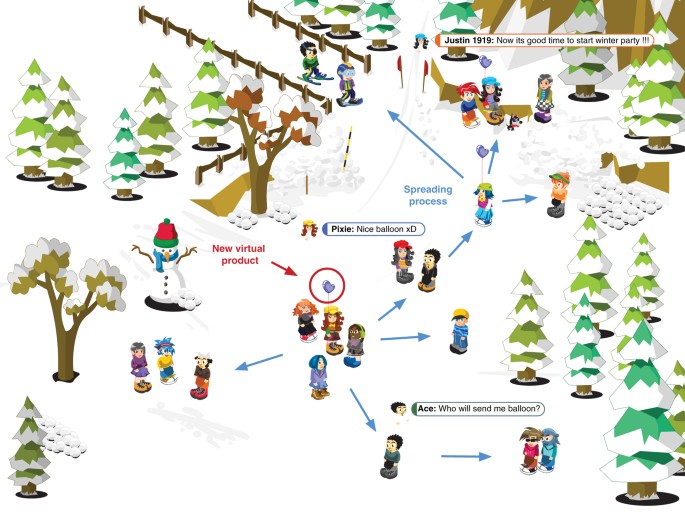
- Select a language for the TTS:
- UK English Female
- UK English Male
- US English Female
- US English Male
- Australian Female
- Australian Male
- Language selected: (auto detect) - EN
Play all audios:
ABSTRACT Metastasis, the dissemination and growth of neoplastic cells in an organ distinct from that in which they originated1,2, is the most common cause of death in cancer patients. This
is particularly true for pancreatic cancers, where most patients are diagnosed with metastatic disease and few show a sustained response to chemotherapy or radiation therapy3. Whether the
dismal prognosis of patients with pancreatic cancer compared to patients with other types of cancer is a result of late diagnosis or early dissemination of disease to distant organs is not
known. Here we rely on data generated by sequencing the genomes of seven pancreatic cancer metastases to evaluate the clonal relationships among primary and metastatic cancers. We find that
clonal populations that give rise to distant metastases are represented within the primary carcinoma, but these clones are genetically evolved from the original parental, non-metastatic
clone. Thus, genetic heterogeneity of metastases reflects that within the primary carcinoma. A quantitative analysis of the timing of the genetic evolution of pancreatic cancer was
performed, indicating at least a decade between the occurrence of the initiating mutation and the birth of the parental, non-metastatic founder cell. At least five more years are required
for the acquisition of metastatic ability and patients die an average of two years thereafter. These data provide novel insights into the genetic features underlying pancreatic cancer
progression and define a broad time window of opportunity for early detection to prevent deaths from metastatic disease. Access through your institution Buy or subscribe This is a preview of
subscription content, access via your institution ACCESS OPTIONS Access through your institution Subscribe to this journal Receive 51 print issues and online access $199.00 per year only
$3.90 per issue Learn more Buy this article * Purchase on SpringerLink * Instant access to full article PDF Buy now Prices may be subject to local taxes which are calculated during checkout
ADDITIONAL ACCESS OPTIONS: * Log in * Learn about institutional subscriptions * Read our FAQs * Contact customer support SIMILAR CONTENT BEING VIEWED BY OTHERS LYMPH NODE METASTASES DEVELOP
THROUGH A WIDER EVOLUTIONARY BOTTLENECK THAN DISTANT METASTASES Article 25 May 2020 CANCER TISSUE OF ORIGIN CONSTRAINS THE GROWTH AND METABOLISM OF METASTASES Article 19 August 2024
EVOLUTIONARY PATHS TOWARDS METASTASIS Article 22 April 2025 REFERENCES * Fidler, I. J. Critical determinants of metastasis. _Semin. Cancer Biol._ 12, 89–96 (2002) Article Google Scholar *
Nguyen, D. X., Bos, P. D. & Massague, J. Metastasis: from dissemination to organ-specific colonization. _Nature Rev. Cancer_ 9, 274–284 (2009) Article CAS Google Scholar * Stathis, A.
& Moore, M. J. Advanced pancreatic carcinoma: current treatment and future challenges. _Nature Rev. Clin. Oncol._ 7, 163–172 (2010) Article CAS Google Scholar * Yachida, S. &
Iacobuzio-Donahue, C. A. The pathology and genetics of metastatic pancreatic cancer. _Arch. Pathol. Lab. Med._ 133, 413–422 (2009) PubMed Google Scholar * Jones, S. et al. Core signaling
pathways in human pancreatic cancers revealed by global genomic analyses. _Science_ 321, 1801–1806 (2008) Article ADS CAS Google Scholar * Maitra, A. & Hruban, R. H. pancreatic
cancer. _Annu. Rev. Pathol._ 3, 157–188 (2008) Article CAS Google Scholar * Lengauer, C., Kinzler, K. W. & Vogelstein, B. Genetic instabilities in human cancers. _Nature_ 396, 643–649
(1998) Article ADS CAS Google Scholar * Jones, S. et al. Comparative lesion sequencing provides insights into tumor evolution. _Proc. Natl Acad. Sci. USA_ 105, 4283–4288 (2008) Article
ADS CAS Google Scholar * Terada, T. et al. Cell proliferative activity in intraductal papillary-mucinous neoplasms and invasive ductal adenocarcinomas of the pancreas: an
immunohistochemical study. _Arch. Pathol. Lab. Med._ 122, 42–46 (1998) CAS PubMed Google Scholar * Hisa, T. et al. Growth process of small pancreatic carcinoma: a case report with imaging
observation for 22 months. _World J. Gastroenterol._ 14, 1958–1960 (2008) Article Google Scholar * Olive, K. P. et al. Inhibition of Hedgehog signaling enhances delivery of chemotherapy
in a mouse model of pancreatic cancer. _Science_ 324, 1457–1461 (2009) Article ADS CAS Google Scholar * Sidransky, D. Emerging molecular markers of cancer. _Nature Rev. Cancer_ 2,
210–219 (2002) Article CAS Google Scholar * Embuscado, E. E. et al. Immortalizing the complexity of cancer metastasis: genetic features of lethal metastatic pancreatic cancer obtained
from rapid autopsy. _Cancer Biol. Ther._ 4, 548–554 (2005) Article CAS Google Scholar * Fu, B. et al. Evaluation of GATA-4 and GATA-5 methylation profiles in human pancreatic cancers
indicate promoter methylation patterns distinct from other human tumor types. _Cancer Biol. Ther._ 6, 1546–1552 (2007) Article CAS Google Scholar * Peiffer, D. A. et al. High-resolution
genomic profiling of chromosomal aberrations using Infinium whole-genome genotyping. _Genome Res._ 16, 1136–1148 (2006) Article CAS Google Scholar * Bignell, G. R. et al. Signatures of
mutation and selection in the cancer genome. _Nature_ 463, 893–898 (2010) Article ADS CAS Google Scholar * Sasaki, K. et al. Relationship between labeling indices of KI-67 and brdurd in
human malignant tumors. _Cancer_ 62, 989–993 (1988) Article CAS Google Scholar * Rew, D. A. & Wilson, G. D. Cell production rates in human tissues and tumours and their significance.
Part II: clinical data. _Eur. J. Surg. Oncol._ 26, 405–417 (2000) Article CAS Google Scholar * Steel, G. G. _The Growth Kinetics of Tumours._ (Clarendon Press, Oxford, 1977) Google
Scholar * Amikura, K., Kobari, M. & Matsuno, S. The time of occurrence of liver metastasis in carcinoma of the pancreas. _Int. J. Pancreatol._ 17, 139–146 (1995) CAS PubMed Google
Scholar * Naumov, G. N. et al. A model of human tumor dormancy: an angiogenic switch from the nonangiogenic phenotype. _J. Natl. Cancer Inst._ 98, 316–325 (2006) Article Google Scholar
Download references ACKNOWLEDGEMENTS This work was supported by National Institutes of Health grants CA106610 (C.A.I.-D.), CA62924 (C.A.I.-D., M.A.N.), CA43460 (B.V.), CA57345 (K.W.K. and
V.E.V.), CA121113 (V.E.V. and K.W.K.), GM078986 (M.A.N.), the Bill and Melinda Gates Foundation Grand Challenges Grant 37874, the Uehara Memorial Foundation (S.Y.), the AACR-Barletta
Foundation (C.A.I.-D.), the John Templeton Foundation, Pilot Funding from the Sol Goldman Pancreatic Cancer Research Center, the Michael Rolfe Pancreatic Cancer Foundation, the George Rubis
Endowment for Pancreatic Cancer Research, the Joseph C. Monastra Foundation for Pancreatic Cancer Research, the Alfredo Scatena Memorial Fund, the Virginia and the D.K. Ludwig Fund for
Cancer Research, The Joint Program in Mathematical Biology and J. Epstein. We would like to acknowledge T. C. Cornish, C. Henderson, N. Omura and S.-M. Hong for their technical assistance in
selected aspects of this work. AUTHOR INFORMATION Author notes * Shinichi Yachida and Siân Jones: These authors contributed equally to this work. AUTHORS AND AFFILIATIONS * Department of
Pathology, The Sol Goldman Pancreatic Cancer Research Center, Johns Hopkins Medical Institutions, Baltimore, 21231, Maryland, USA Shinichi Yachida, Baojin Fu, Mihoko Kamiyama, Ralph H.
Hruban, James R. Eshleman & Christine A. Iacobuzio-Donahue * The Ludwig Center for Cancer Genetics and Therapeutics and The Howard Hughes Medical Institute at The Johns Hopkins Kimmel
Cancer Center, Baltimore, 21231, Maryland, USA Siân Jones, Rebecca Leary, Victor E. Velculescu, Kenneth W. Kinzler & Bert Vogelstein * Department of Mathematics, Department of Organismic
and Evolutionary Biology, Program for Evolutionary Dynamics, Harvard University, Cambridge, 02138, Massachusetts, USA Ivana Bozic, Tibor Antal & Martin A. Nowak * School of Mathematics,
University of Edinburgh, Edinburgh EH9 3JZ, UK Tibor Antal * Department of Oncology, The Sol Goldman Pancreatic Cancer Research Center, Johns Hopkins Medical Institutions, Baltimore, 21231,
Maryland, USA Ralph H. Hruban & Christine A. Iacobuzio-Donahue * Department of Surgery, The Sol Goldman Pancreatic Cancer Research Center, Johns Hopkins Medical Institutions, Baltimore,
21231, Maryland, USA Christine A. Iacobuzio-Donahue Authors * Shinichi Yachida View author publications You can also search for this author inPubMed Google Scholar * Siân Jones View author
publications You can also search for this author inPubMed Google Scholar * Ivana Bozic View author publications You can also search for this author inPubMed Google Scholar * Tibor Antal View
author publications You can also search for this author inPubMed Google Scholar * Rebecca Leary View author publications You can also search for this author inPubMed Google Scholar * Baojin
Fu View author publications You can also search for this author inPubMed Google Scholar * Mihoko Kamiyama View author publications You can also search for this author inPubMed Google
Scholar * Ralph H. Hruban View author publications You can also search for this author inPubMed Google Scholar * James R. Eshleman View author publications You can also search for this
author inPubMed Google Scholar * Martin A. Nowak View author publications You can also search for this author inPubMed Google Scholar * Victor E. Velculescu View author publications You can
also search for this author inPubMed Google Scholar * Kenneth W. Kinzler View author publications You can also search for this author inPubMed Google Scholar * Bert Vogelstein View author
publications You can also search for this author inPubMed Google Scholar * Christine A. Iacobuzio-Donahue View author publications You can also search for this author inPubMed Google Scholar
CONTRIBUTIONS Sample collection and processing was performed by C.A.I.-D., S.Y., B.F. and M.K. Microdissection, DNA extractions and whole genome amplification reactions were performed by
S.Y. Sequencing was performed by S.J. Copy number analyses were performed by R.L. Computational models and estimates of clonal evolution were performed by I.B., T.A. and M.A.N.; C.A.I.-D.,
S.Y., S.J., R.H.H., J.R.E., M.A.N., I.B., T.A., V.E.V., K.W.K. and B.V. directed the research. C.A.I.-D., B.V., S.Y., I.B. and T.A. wrote the manuscript, which all authors have approved.
CORRESPONDING AUTHOR Correspondence to Christine A. Iacobuzio-Donahue. ETHICS DECLARATIONS COMPETING INTERESTS The authors declare no competing financial interests. SUPPLEMENTARY INFORMATION
SUPPLEMENTARY INFORMATION This file contains a Supplementary Discussion, additional references, Supplementary Figures 1-8 with legends and Supplementary Tables 1-6. (PDF 679 kb) POWERPOINT
SLIDES POWERPOINT SLIDE FOR FIG. 1 POWERPOINT SLIDE FOR FIG. 2 POWERPOINT SLIDE FOR FIG. 3 RIGHTS AND PERMISSIONS Reprints and permissions ABOUT THIS ARTICLE CITE THIS ARTICLE Yachida, S.,
Jones, S., Bozic, I. _et al._ Distant metastasis occurs late during the genetic evolution of pancreatic cancer. _Nature_ 467, 1114–1117 (2010). https://doi.org/10.1038/nature09515 Download
citation * Received: 11 May 2010 * Accepted: 15 September 2010 * Published: 27 October 2010 * Issue Date: 28 October 2010 * DOI: https://doi.org/10.1038/nature09515 SHARE THIS ARTICLE Anyone
you share the following link with will be able to read this content: Get shareable link Sorry, a shareable link is not currently available for this article. Copy to clipboard Provided by
the Springer Nature SharedIt content-sharing initiative








